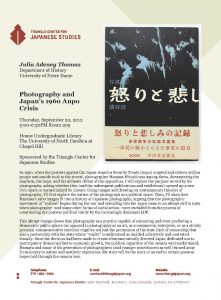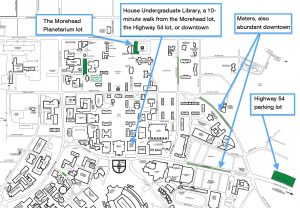 “In 1960, when the protests against the Japan-America Security Treaty (Anpo) erupted and sixteen million people nationwide took to the streets, photographer Hamaya Hiroshi was among them, documenting the mayhem, the hope, and the ultimate defeat of the opposition. I will explore the purpose served by his photographs, asking whether they (and the subsequent publications and exhibitions) opened up a new civic space or memorialized its closure. Using images and drawing on contemporary theories of photography, I’ll first explore the nature of the photograph as a political space. Then, I’ll show how Hayama’s 1960 images fit into a history of Japanese photography, arguing that the photographic movement of “realism” begun during the war and extending into the 1950s came to an abrupt end in 1960 when photography–and many other forms of social action–were excluded from the process of constructing the postwar political reality by the increasingly dominant LDP. This abrupt change shows is that photography as a practice capable of enhancing and even producing a democratic public sphere (as opposed to photography as an art, as a commercial enterprise, or as a strictly personal commemorative exercise) requires not just the permission of the state (lack of censorship) but also a partnership with the state where “reality” is understood as molded collectively and contested visually. Once the decision had been made to create a bureaucratically directed Japan dedicated not to participatory democracy but to economic growth, the political capacities of the camera were undermined. Hamaya and many of his generation of photographers (and younger practitioners as well) turned away from society to nature and aesthetic expression. My story will be the story of an end to certain postwar hopes told through the camera lens.”
“In 1960, when the protests against the Japan-America Security Treaty (Anpo) erupted and sixteen million people nationwide took to the streets, photographer Hamaya Hiroshi was among them, documenting the mayhem, the hope, and the ultimate defeat of the opposition. I will explore the purpose served by his photographs, asking whether they (and the subsequent publications and exhibitions) opened up a new civic space or memorialized its closure. Using images and drawing on contemporary theories of photography, I’ll first explore the nature of the photograph as a political space. Then, I’ll show how Hayama’s 1960 images fit into a history of Japanese photography, arguing that the photographic movement of “realism” begun during the war and extending into the 1950s came to an abrupt end in 1960 when photography–and many other forms of social action–were excluded from the process of constructing the postwar political reality by the increasingly dominant LDP. This abrupt change shows is that photography as a practice capable of enhancing and even producing a democratic public sphere (as opposed to photography as an art, as a commercial enterprise, or as a strictly personal commemorative exercise) requires not just the permission of the state (lack of censorship) but also a partnership with the state where “reality” is understood as molded collectively and contested visually. Once the decision had been made to create a bureaucratically directed Japan dedicated not to participatory democracy but to economic growth, the political capacities of the camera were undermined. Hamaya and many of his generation of photographers (and younger practitioners as well) turned away from society to nature and aesthetic expression. My story will be the story of an end to certain postwar hopes told through the camera lens.”
Sponsored by the Triangle Center for Japanese Studies.
Parking: There are several visitor parking options close to the House Undergraduate Library.

DATE: September 20, 2012
LOCATION: Room 205, House Undergraduate Library, UNC
TIME: 5:00-6:30pm
"Photography and Japan's 1960 Anpo Crisis" – Julia Adeney Thomas, University of Notre Dame
Comments are closed.
